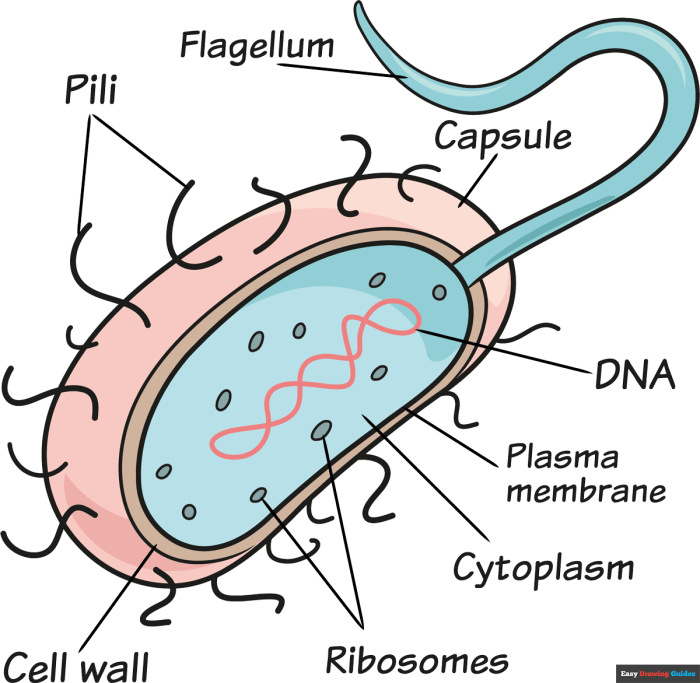Creating a Step-by-Step Drawing Guide: A Easy Drawing Of Bacteria

A easy drawing of bacteria – Let’s dive into the fun part: actually drawing these microscopic marvels! We’ll create simple, yet recognizable, representations of three common bacterial shapes. Remember, these are simplified versions; real bacteria are far more complex.
Illustrating a simple bacterium is surprisingly similar to depicting complex systems; you need to focus on key features. For instance, understanding the simplified representation of a single cell helps appreciate the visual representation of larger, more intricate systems, such as a parliamentary democracy easy drawing , where each component, like a party, needs to be clearly defined. Returning to our bacteria, the simplicity of the drawing allows for a focus on the essential aspects of its structure.
Drawing bacteria is a great way to visualize their basic shapes and understand their diversity. Accuracy in depicting their shapes is crucial for understanding their characteristics and potential implications. The following steps will guide you through creating simple, yet informative drawings of different bacterial morphologies.
Drawing a Coccus Bacterium
Coccus bacteria are spherical in shape. Drawing them is surprisingly straightforward.
- Start with a perfect circle. Use a compass or freehand, aiming for a smooth, even curve.
- That’s it! A single circle represents a single coccus bacterium. You can draw multiple circles to show clusters or chains, depending on the bacterial species you’re representing.
- For added detail, you can lightly shade one side of the circle to create a three-dimensional effect, suggesting light and shadow. This makes the drawing more visually engaging.
Drawing a Bacillus Bacterium
Bacillus bacteria are rod-shaped. Getting the proportions right is key here.
- Begin by drawing a slightly elongated oval or rectangle. Aim for a shape that’s about twice as long as it is wide. This establishes the basic bacillus form.
- To add realism, round off the corners slightly. Sharp corners are uncommon in bacterial cells.
- Now, for shading: Imagine a light source above. Lightly shade the bottom or side opposite the light source to give the bacillus a three-dimensional feel. Keep the shading subtle and even.
- You can draw multiple bacilli to show their arrangement (e.g., chains or clusters) and illustrate different species.
Drawing a Spirillum Bacterium, A easy drawing of bacteria
Spirilla are spiral-shaped bacteria. Capturing their curves accurately is essential.
- Start by sketching a gentle, elongated S-curve. This forms the basic spiral shape of the spirillum.
- Refine the curve, ensuring it’s smooth and consistent. Avoid sharp angles or jagged edges; spirilla have a graceful, flowing form.
- To enhance the three-dimensionality, add subtle shading along the inner curves of the spiral. This creates the illusion of depth and volume.
- Remember that spirilla can have varying numbers of spirals. Experiment with different curve lengths to represent different species.
Adding Details to Enhance the Drawing

Now that we have a basic bacterial shape, let’s add some details to make it more realistic and informative. Adding these features will elevate your drawing from a simple circle to a representation that accurately reflects the diversity and complexity of the bacterial world. Remember, we’re aiming for simplicity and clarity, not photorealism.Adding details like flagella, pili, capsules, or endospores helps to illustrate specific bacterial characteristics and functions.
These structures are not always present in all bacteria, so choose details that are appropriate for the type of bacteria you are depicting. For instance, you wouldn’t add flagella to a bacteria known to be non-motile.
Flagella and Pili
Flagella are whip-like appendages used for movement. To draw them, simply add a few thin, wavy lines extending from one or both ends of the bacterium. Pili, on the other hand, are shorter and straighter, often depicted as numerous, hair-like structures protruding from the bacterial surface. These are involved in attachment and genetic exchange. Keep the lines simple; a few strategically placed lines will suffice to represent these structures without cluttering your drawing.
Imagine a few thin, slightly curved lines emanating from the cell body for flagella, and shorter, thinner, straight lines for pili, densely packed in certain areas.
Capsules and Endospores
A bacterial capsule is a protective outer layer. Represent this by drawing a slightly hazy, larger halo around the bacterium. Think of a soft, slightly uneven circle surrounding the main bacterial cell. Endospores are dormant, resistant structures formed by some bacteria under stressful conditions. These are drawn as a smaller, denser, oval shape located inside the main bacterial cell.
Picture a smaller, darker oval inside the main bacterial cell, representing the spore’s protective nature.
Binary Fission
Binary fission is the process of bacterial cell division. To illustrate this, draw a single bacterium, then draw a slightly smaller, identical bacterium beginning to form alongside it, connected by a thin line representing the division process. Finally, draw two separate bacteria, showing the completion of the division. This simple sequence, using just a few basic shapes, effectively visualizes this fundamental biological process.
Think of two circles, slightly overlapping initially, then separating to form two individual circles. A thin line connecting the overlapping circles would represent the septum forming during cell division.
Question & Answer Hub
What materials do I need to draw bacteria?
Pencil, paper, eraser, and colored pencils or markers (optional). Simple tools are all you need!
How important is accuracy in a simple bacteria drawing?
While simplicity is key, capturing the basic shape (coccus, bacillus, spirillum) and key structures like the cell wall is important for accurate representation.
Can I draw bacteria from memory after practicing?
Absolutely! Practice with the step-by-step guides, and soon you’ll be able to visualize and draw bacteria from memory.
Are there online resources to help me improve my bacterial drawings?
Yes! Search online for “microscopy images” or “bacterial cell diagrams” for visual references.

